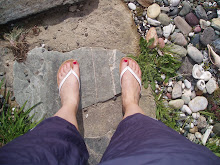Reflection on the Collaborative Task Process
Due: 5th June 2009Overall I feel that my contribution to the collaborative research project has been sufficient, and the journey taken has been personally enlightening. Below I have listed my:
Contribution to the group:
- Created the google doc for the group to use as the format structure for the group proposal
- Coordinated the meeting of the group on two occasions, but this was generally a mutual consensus
- Provided 5 references and intuitive ideas regarding the research question
- Was present at most group meetings and actively involved with the process
Contribution to the references:
- Information on ethics and data analysis relevant to our group proposal: Cohen, Manion & Morrison (2007)
- The effect of massage on the parasympathetic nervous system and the resultant relaxation effect, and how this would assist Chronic pain clients: Marieb (2004)
- The presence of chronic local adaptation syndrome in clients suffering from chronic pain: McQuillan (2008)
- Descriptions of chronic pain symptoms from an anonymised client, potential link between chronic pain and emotional/psychological trauma, referral of chronic pain patients to massage therapists by other healthcare providers: S. Farrimond, personal communication (2009)
- Links between neurophysiology/peripheral nerve pathways and chronic pain from a medical perspective: McQueen, personal communication (2009)
My Interpretations of the Topic:
At the conclusion of this group collaborative research proposal, I feel there is a strong link between chronic pain and emotional disorders, oversensitivity of the peripheral nerve pathways and chronic pain syndrome fits the profile of an individual prone to anxiety and depression. I feel that due to the lack of research to date conducted in the field of chronic pain there is a potential area for further exploration into the phenomena that is chronic pain syndrome. Our research indicates that massage therapy would play a viable role in the control and treatment of chronic pain symptoms, on both a physical and emotional level.
So far, the medical system has attempted to treat chronic pain (e.g. with the instigation of pain clinics within hospitals nationwide (McQueen, personal communication, 2009)), but due to the lack of research and therefore lack of knowledge of this condition and its fundamental nature, the healthcare profession continues to be mystified by chronic pain sufferers and the syndrome itself, placing it in the 'too hard' basket.
I feel this offers an area of research particularly relevant to the Massage Therapy profession to explore in the future and the vital role massage could play in the treatment process.
My engagement with the group:
Initially, I attempted to act as coordinator for the meeting of our group, but as a result of the progression of the task I found myself leaning toward the editor style role, editing and culling the information rather than adding further research.
I enjoyed this editing role more so than the role of researcher or coordinator, as I felt it suited my aptitude with language and writing.
I was a present force at most of the group meetings, continually engaging with the others and the task at hand.
My involvement with the workload:
I feel I contributed an acceptable portion of the references required, assisted with arranging group meetings and liaised with the other group members in a concerted manner throughout the group task. I believe I was appropriately involved with the journey taken by the proposal, from its initial formative stages through to its completion and presentation as a google document.
As a result of this collaborative group task process I have become interested in the role that massage therapy may play in the future, in relation to undefined/seldom researched health conditions. I have also discovered my strengths (and passions) lie mainly within the realm of the written word and editing, rather than in management or as a researcher with regards to this group project.
References:
Grinlinton, T., Howley, H., Marks, S. & Steven, S. (2009) Collaborative Research Project: How Many Massage Sessions Does it Take to Reduce the Sudden Onset of Chronic Pain Symptoms? Dunedin: Otago Polytechnic Massage Therapy School.
My own thoughts.

No comments:
Post a Comment